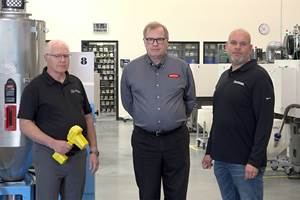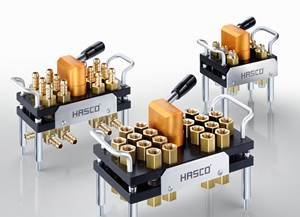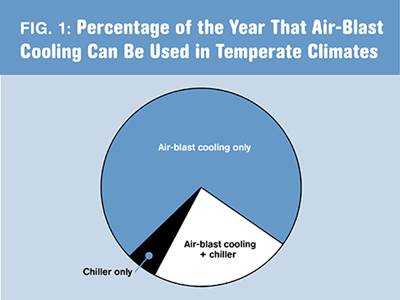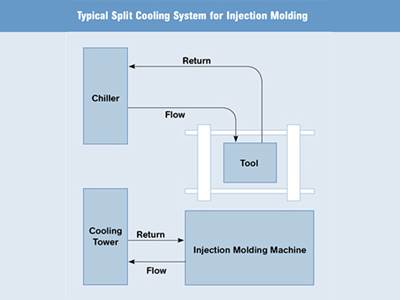Optimize Cooling Water Supply To Reduce Distribution Costs
Reducing distribution costs for cooling and chilled water is often one of the easiest and quickest methods of reducing energy use in water cooling, yet most plants have never investigated this area.
This is the last of five articles on minimizing energy waste in water-cooling systems. (Previous installments were in March, May, and September 2012 and January 2013.) The last article examined what can be done on the supply side—cooling towers, chillers, and air coolers. Now we’ll look at minimizing expenses in distributing cooled or chilled water.
Reducing distribution costs for cooling and chilled water is often one of the easiest and quickest methods of reducing energy use in water cooling, yet most plants have never investigated this area. The water circulation pumps for cooling and chilling systems are generally centrifugal pumps and these are often incorrectly sized for the demand. This is either due to expansion/contraction of the system, poor initial specification, or changes to the system that have not been logged correctly. The cooling-water map (see March 2012) is an invaluable tool in locating these changes to the system and can act as a road map to saving energy.
Changes in the system often mean that pipe work has been modified without considering the resulting alteration in the load and efficiency of the pumps at the increased or decreased pressures. The pipe work and pumps must be sized for the current demands. Large pumps operating at low loads will be less efficient than small pumps operating closer to their maximum load.
Isolate machines and processes if they are not required. This should be as far back in the system as possible to reduce pressure losses to a minimum.
COOLING-WATER PUMPS
Most cooling-water pumps will be located in the plant room and will never be seen by most of the staff. But remember: A simple 25-hp pump will consume around $16,000 of energy per year. This is expensive equipment.
A typical (very simplified) cooling-water layout is shown in the accompany diagram. This will have pumps supplying water to both the process and the cooling system. The water volume flow to the process can be matched to the demand by pump sequencing (where a site has multiple pumps) or preferably by the use of variable-speed drive controllers using the pressure or the flow rate as a control signal.
Where multiple pumps are used, then a simple control system can be used to optimize the number of pumps running at any one time by sensing the pressure and temperature of the flow and return. Installation of variable-speed drives (VSDs, also known as variable-frequency or inverter drives) on the process pumps allows tuning of the system to the demands of the process.
Rather than operate the pumps at full speed regardless of the process demand, a VSD can vary the flow rate of the pump to match the needs of the process. The speed of the pump can be controlled by taking a signal from the cooling-water return piping before the sump. When the process demand is low then the VSD will slow the pump down, and when the process demand is high it will speed the pump up. This simple system will also reduce temperature variations in the cooling-water circuit and provide better process control. As a general rule, the application of VSDs to a cooling-water process circuit will have a payback of around six months or less.
Use VSDs to control pumps to produce a constant pressure or flow rate. It may be necessary to have dual sensors to monitor and control both the temperature and the pressure, but the pressure is usually simply a limit control—i.e., the pressure should not be less than 4 bar.
For multiple-pump systems, a VSD is generally only needed on one pump. The remaining fixed-speed pumps can provide the base load and the VSD-controlled pump can provide the variable load. The number of fixed-speed pumps running can also be controlled according to the demand.
The benefits of VSDs will increase if machines are isolated from the cooling-water circuit when they are not being used. The cooling water will then return colder and the pump will slow down even more.
It is also possible to consider using VSDs for the cooling-water pumps to the system (cooling tower or air-blast cooler). These pump drives need a suitable control system.
CHILLED-WATER PUMPS
Most chilled-water pumps are similar to the cooling-water pumps and the simplified system layout shown here is also broadly applicable to the chilled-water system. The pumps are often of the same size and cost the same amount to operate.
Chilled-water pumps are also mainly fixed-speed pumps and operate irrespective of the process demand. As with the cooling-water pumps, it is possible to fit VSDs to the process chilled-water pumps. This will provide the same benefits as for the cooling-water pumps—reduced energy consumption and improved chilled-water temperature stability. As a general rule, the application of VSDs to a chilled-water process circuit will have a payback of around six months or less.
Use VSDs to control pumps to produce a constant pressure or flow rate. As with cooling-water pumps, it may be necessary to have dual sensors to monitor and control both temperature and pressure.
For multiple pump systems, a VSD is generally needed on only one pump (see above for cooling-water systems).
Chilled-water pumps to the system (chillers or air-blast precoolers) may not be suitable for VSDs. Unless chillers are efficient at partial loads, the best performance will be when they are force-fed from the chilled-water sump. For many older chillers it is better for the chiller to turn off when the setpoint temperature is reached rather than to run at reduced demand. This is because of the general reduction in chiller efficiency at partial loads. New-design chillers often have good partial-load efficiency, and therefore the use of a VSD for the system side of the chilled-water system can be considered.
The benefits of VSDs will increase if tooling is isolated from the chilled-water circuit when it is not being used. The chilled water will then return colder and the pump will slow down even more.
SIMPLE CHANGES
In one real-world case, a plant had fixed-speed main and standby pumps for the cooling water from the sump to the process. The main pump was 30 hp and the standby pump was 25 hp. It was known that the 25-hp pump worked fine for the system demands and had run the system for extended periods when the 30-hp pump was being serviced. Despite this, the system was always run using the 30-hp pump.
Simply switching the control system so that the 25-hp unit was the main pump and the 30-hp model was the standby pump saved over $4000/yr. This was replicated on three other systems (another cooling-water system and two chilled-water systems) to save over $16,000/yr for exactly the same cooling capacity.
Related Content
Captive Molder Beefs Up Auxiliaries to Boost Quality, Consistency
SeeScan adds conveying, drying, feeding and chilling technologies to improve quality — and enhance employee safety — in production of its underground/underwater inspection systems.
Read MoreMulticoupling Range Extended
Hasco‘s quick-connect system for multiple cooling circuits has added U.S., French and HT versions.
Read MoreImprove The Cooling Performance Of Your Molds
Need to figure out your mold-cooling energy requirements for the various polymers you run? What about sizing cooling circuits so they provide adequate cooling capacity? Learn the tricks of the trade here.
Read MoreHow to Reduce Sinks in Injection Molding
Modifications to the common core pin can be a simple solution, but don’t expect all resins to behave the same. Gas assist is also worth a try.
Read MoreRead Next
Optimize Cooling Water Supply To Reduce Costs
In the last three articles (March, May, Sept. 2012), we introduced the problem of wasted energy in cooling-water systems and presented two types of solutions—minimizing “parasitic” heat gains and raising water temperatures to minimize demand.
Read MoreCooling Water: Minimize Demand by Reducing Heat Gains
In March, we introduced the subject of energy savings through cooling-water management.
Read MoreEnergy Miser: For Energy-Efficient Water Cooling, Raise Temperatures to Cut Demand
Many plants use chilled-water temperatures that are far lower than are actually needed by the process. This has a direct effect on the cost of chilled water.
Read More
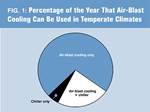
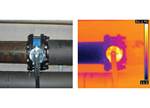
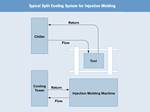






.png;maxWidth=300;quality=90)









